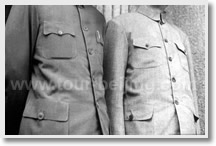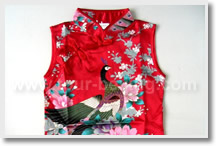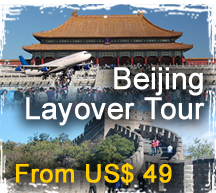China's Traditional Clothing
Today’s clothing — Chinese FolkloreChina’s fashion designers use a mixture of traditional and modern ideas to create new fashions. These new fashions also incorporate age-old motifs such as guardian deities, lions, and masks of Chinese opera characters.
Chinese bronze is another source of printed, woven, and embroidered design for clothes. Some of the distinctive designs include dragons, phoenixes, clouds, and lighting.
In modern society, Chinese men are seen at social occasions wearing ceremonial clothes in two varieties on formal occasions, i.e. the dignified and refined traditional Chinese long gown and the SunYat-sen’s uniform, which is a creative blending of fashion elements from the East and West, and a milestone in the history of Chinese garment design-was hailed as the “State Suit”.
While women often wear the ch’i-p’ao. The variations of height, length, width, and ornamentation of the collar, sleeves, skirt, and basic cut of this Oriental fashion are limitless. Are
Changes of Men’s and Women’s Costume — Chinese Folklore
Men wore western-style clothes and Sun Yat-sen’s uniform (Chinese tunic suit). These two style of clothes were foreign styles, and most officials and intellectuals more usually wore them. White garments were worn in summer, but black or dark ones in other seasons.

The style with a mandarin jacket over a long gown was still one of the common dressing styles. The student’s clothing with erect collars, three pockets and seven buttons were mainly the uniform of students of universities and colleges. In addition, typical clothes of rural men and women included a jacket and trousers or covered with a ramie skirt.
Women’s costume changed greatly during the period, some kept the Qing Dynasty (1644-1912) style of trousers and clothes with curving front, some imitated western-style with a jacket and a skirt, most schoolgirls wore black silk skirts and short jackets that had a round lower hem and short sleeves to elbow. The common garments of social women were manly Chi-pao.
In the 1920s, people began to wear Chi-pao whose style was mostly the same as that of the Qizhuang existing at the end of Qing Dynasty. Later, the cuff was reduced gradually, and embroidered border was not as broad as the previous one. By the early 1930s, Chi-pao had been very popular.
The main changes of garments in that time were the modifications of collar, sleeve and length, etc. The garments with high collar were popular first, and the higher the collar, the more popular. Gradually, garments with low collars began to be popular, and the lower the collar, the more modern. Finally, people wore collarless and sleeveless Chi-pal.
Chinese’s Modern Clothing — Chinese Folklore
After the 1911 Revolution, the garments changed greatly, and the dresses and the official cap were eliminated. Particularly, hair plaits were cut off, but chi-pao still exist. The Blue Short Gown of schoolgirls was the main style, and it gradually became popular.

The government specified the system of formal dresses of men and women in the first year of the Republic of China. Men had dress suits and routine suits. Dress suits included day suit and evening suits, which were all made of black cloth, trousers and cravats. Routine suits included Western style and Chinese style (e.g. long gown and mandarin jacket). The formal dress of women had collars and was long to the knees with buttons down the front. Skirt were decorated with cartouches in the front and back, both sides were sewn with pleats, and both ends had patterns of knots.
Along with the emergence of cinema, film stars became eminent figures gradually. Shanghai City became the base camp of women’s wear in China. The garments of Guangdong Province and Hong Kong became one of the branches of Shanghai City garments.
China’s Ancient Clothing — Chinese Folklore
China’s traditional clothing is characterized as magnificent. An outstanding characteristic of traditional Chinese clothing is not only an external expression of elegance, but also an internal symbolism. Each and every piece of traditional clothing communicates a sense of external form with internal symbolism of clothing is clearly exemplified in the pair of fighting pheasant feathers used in head wear originating in the battle wear of the Warring States period (457-221BC).
The three main types of traditional Chinese clothing are the pien-fu, the ch’ang-p’ao, and the shen-i. The pien-fu is an ancient two-piece ceremonial costume of a tunic-like top extending dto the knees and a skirt or trousers extending to the ankles. The Ch’ang-p’ao is a one –piece garment extending from the shoulders all the way to the heels. The shen-i is a cross between the pien-fu and the ch’ang –pao.
Consequently, the shen-i was the most widely worn o the three types. Typical of these three types of clothing were wide and voluminous sleeves and a very loose fit. So because of their relatively plain design and structure, embroidered edgings, decorated bands, draped cloth or skills, patterns on the shoulder, and sashes were often added as ornaments. Variety in designs came to be one of the unique features of traditional Chinese dress.
Darker colors were favored over lighter ones in traditional Chinese clothing, so the main color of ceremonial clothing tended to be dark while bright, elaborate tapestry designs was worn more frequently by the common people for everyday life and around the house use. The Chinese associate certain colors with specific seasons: green represents spring, red symbolizes summer, white represents autumn, and black symbolizes winter. The Chinese are said to have a fully developed system of matching, coordinating, and contrasting colors in apparel.
Questions & Answers:



